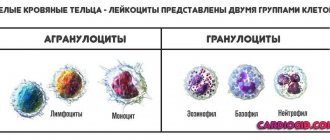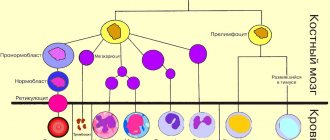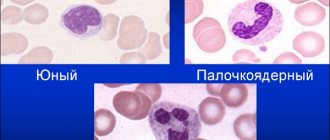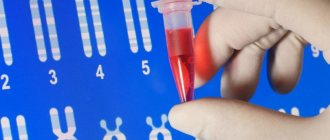What kind of cells are neutrophils?
Neutrophilic leukocytes or neutrophils are the most numerous type of white blood cells.
They are formed in the bone marrow, where they undergo a series of stages during maturation. A myeloblast is formed from a precursor cell. The next cell is the promyelocyte. From it a myelocyte is formed, and then a metamyelocyte. These neutrophils are called juveniles. From them, rod forms mature. Further, mature cells – segmented neutrophils – are formed from them.
All types of neutrophil leukocytes differ from each other at different stages: the shape of the nucleus, the presence of granules. For example, segmented neutrophils contain a nucleus divided into segments.
The granules contained in the cytoplasm of neutrophils provide their ability to perform their biological functions.
The presence of granules in the cytoplasm of neutrophils allows them to be classified as granulocytic leukocytes. In addition to neutrophils, they also include eosinophils and basophils.
The main task of these cells is to fight foreign agents that enter our body. Therefore, there is a relationship between the content of these leukocytes and the presence of an infectious process.
Photo: https://moyakrov.info/blood/prichiny-povysheniya-ili-ponizheniya-segmentoyadernyh-nejtrofilov
Norms for neutrophil levels in children
The normal content of neutrophils in children is presented in Table 1. There are two main types of neutrophil leukocytes: band and segmented. Also, the units of measurement of a given type of cell will be presented in the form of relative and absolute values.
Absolute values show the content of a given cell type in the blood, expressed as 10 * 9 per liter. Relative numbers show how many cells of a given type were detected out of 100. Then the unit of measurement will be percentages.
Table 1. Norm of neutrophils in children.
| Age group | Absolute values | Relative values | |
| Rod | Segmented | ||
| Less than one year | 1.5 – 8.5 * 10*9/liter | 0,5 – 4 % | 15 – 45 % |
| One year – six years | 1.5 – 8.5 * 10*9/liter | 0,5 – 5 % | 25 – 60 % |
| From seven to twelve years | 1.8 – 8 * 10*9/liter | 0,5 – 5 % | 35 – 65 % |
| Over thirteen years old | 1.8 – 7.7 * 10*9/liter | 0,5 – 6 % | 47 – 72 % |
Treatment
The therapeutic program is aimed at strengthening the immune system. For therapeutic purposes the following may be prescribed:
- vitamins (Vitrum, Complivit for children);
- enhanced nutrition - emphasis is placed on vegetables and fruits, protein foods;
- therapeutic exercises - outdoor games, swimming, running are suitable;
- if there is a concomitant disease, antibiotics, adsorbents, and immunomodulators are taken.
The last group of drugs is prescribed only by a doctor after identifying the underlying pathology. The main goal of treatment is to increase neutrophils in the blood and prevent the development of complications.
A child’s protective bodies are reduced in acute and chronic pathologies. Rarely, this condition is congenital. Young segmented forms are most often affected. When a deviation develops, you should pay attention to lymphocytes, an increase in the number of which indicates a viral disease. It is necessary to be treated immediately. Strengthening medications and health procedures are indicated.
Author: Denis Filin, doctor, especially for Mama66.ru
Why are neutrophils low in a child?
The majority of neutrophils are segmented. Therefore, the reasons that segmented cells are reduced may be:
- disruption of the formation of neutrophil leukocytes in the bone marrow , for example, as a result of a malignant process;
- rapid death of neutrophils after performing their function - destroying the infectious agent. That is, with an excess of pathogenic agents, the body does not have time to produce new cells, their content decreases;
- a change in the number of other types of white blood cells , resulting in a change in the relative importance of the cells. Therefore, in this case it is better to take into account the absolute values of cells in the blood.
A decrease in the number of neutrophil leukocytes is called neutropenia.
Thus, the presence of some infectious diseases is accompanied by the fact that segmented neutrophils are reduced in children. Examples of such diseases may be:
- rubella;
- hepatitis;
- chickenpox;
- flu;
- fungal infection and others.
Photo: https://pixabay.com/photos/cold-headaches-health-influence-3861935/
Segmented neutrophils are below normal
When deciphering the leukocyte formula in a general blood test, much attention is paid to the ratio of different forms of neutrophils. The change in their number relative to each other is called a shift. This indicator is very important in diagnosing various diseases.
A shift in the leukocyte formula can be to the left (young forms predominate) and to the right (the level of young neutrophils is lower than aging forms, which means normal).
It's in the child's blood
When the leukocyte formula shifts to the left, the relative number of segmented neutrophils may decrease in favor of young and immature species (metamyelocytes, myelocytes and band ones). The total number of leukocytes should also be assessed, because the ratio may not change, while the total number will be progressively reduced until it “fails.”
Changes in the leukocyte formula may be a normal response of the body to the influence of a pathogenic factor. In another case, especially when degenerative forms that differ sharply from normal ones appear in the analyses, it indicates a sharp deterioration in the child’s condition and requires immediate intervention and clarification of the causes.
Structure of a segmented neutrophil
In a baby
Infants are well protected from infection, because mother’s milk contains many immune cells that successfully fight bacteria and viruses. If the baby is bottle-fed, the risk of developing diseases and complications after them increases.
With recurrent infections, a small child may develop neutropenia with the appearance of unusual segmented neutrophils - binuclear. If the number of segments is reduced, this is due to their death and redistribution in the blood and tissues during the fight against pathogenic microorganisms. If the disease does not go away for a long time, then exhaustion sets in: active immune cells have already died, and new ones have not had time to be synthesized. Normal hemoglobin level in a child.
One of the most common reasons why segmented neutrophils are low, in addition to severe infections, is an autoimmune process in the infant’s body. It develops due to its own congenital problems with the immune system (systemic lupus erythematosus, rheumatoid arthritis) or as a result of Rh incompatibility of the mother and fetus in antigenic structure.
You should be careful about medications prescribed to young children, because the use of some medications can lead to agranulocytosis (a critical decrease in the level of segmented leukocytes). This is especially true for antibiotics of the sulfonamide group (Biseptol) and non-steroidal anti-inflammatory drugs used in pediatric practice (Analgin, ibuprofen).
In a newborn
To correctly interpret the analysis, you should know that up to 3-7 days in a newborn child, the number of segmented neutrophils and lymphocytes is the same as in an adult. After this, the first physiological crossover occurs and a state of relative neutropenia occurs in combination with absolute lymphocytosis (increased content).
If the number of segmented neutrophils in the blood of a newborn child is reduced, parents should be wary of congenital and hereditary forms of the disease.
Such diseases include:
- infantile agranulocytosis;
- congenital cyclic neutropenia (the disease is interesting because every few weeks there is a decrease in the number of neutrophils);
- benign ethnic familial neutropenia (characteristic of several specific population groups).
When children are referred for testing
Determining the level of neutrophils in the blood is included in such an indicator as the leukocyte formula. It involves counting the types of leukocytes. The calculation of the leukocyte formula is most often included in the CBC (general clinical blood test).
The purpose of this blood test is to:
- assess the child’s condition in the absence of any complaints during a routine examination;
- identify the presence of an infectious process if it is suspected, especially when there are clinical manifestations;
- identify disorders of blood cell content as a result of a hereditary disorder or tumor process.
That is, the CBC is a simple but quite informative blood test, which is prescribed for preventive purposes, as well as for any disease.
Neutrophil function and indications for their determination
The leukocyte formula gives a general idea of human immunity and includes a harmonious ratio of five leukocytes: monocytes, eosinophils, lymphocytes, neutrophils and basophils. Violation of the norm of these indicators in a general blood test helps to recognize pathologies, including malignant neoplasms.
Indications for a general blood test, in particular to determine the quantitative ratio of the neutrophil fraction, are the following diseases:
- upper respiratory tract diseases (sore throat and pneumonia);
- pathologies of parenchymal organs (pancreatitis and cholecystitis);
- sepsis, gangrene and extensive burns of the skin;
- heart attack;
- tuberculosis;
- hypoplastic and aplastic anemia;
- blood loss;
- appendicitis and peritonitis;
- chemical poisoning;
- rheumatic attacks.
In general, leukocytes perform a protective function for the body: they create a barrier to pathogenic microflora (infections, viruses and bacteria), and are also designed to absorb pathogenic bacteria, the products of their vital activity and decay.
When a virus enters the human body or an inflammatory process begins, the body temperature rises, thus the immune system fights the pathogen. Read more in the article: “lowering body temperature at home.”
The leukocyte protective barrier involves the complex functioning of individual factions, each of which strictly performs its own functions. Thus, the task of neutrophils is to absorb pathogenic microorganisms and break them down in their own body. Having completed its “mission,” the neutrophil lymphocyte dies, forming exudate and attracting other leukocyte cells. At the same time, the neutrophil secretes antibacterial substances and enzymes.
The mechanism is simple: if there is a focus of inflammation in the body, a segmented (adult) neutrophil from the blood is directed to the pathogenic focus, so its quantitative ratio with other leukocytes in the blood stream may temporarily decrease. A sharp decrease in cell levels in some cases occurs due to intensive therapeutic methods such as radiation or chemical therapy.
Preparing for analysis
In order to find out the number of neutrophil leukocytes, you need to donate blood from a finger or from a vein. This biological material must be taken on an empty stomach in children over five years of age. It is recommended not to feed infants for 30 minutes before blood sampling, and for children under five years old - for 3 to 4 hours.
It is also desirable that the patient does not experience emotional overload. Parents should motivate their child to withstand the “finger prick” and explain that there is nothing wrong with it.
Parents should also make sure that the child does not run around the hospital corridors before the blood is drawn.
The baby's hands should be warm. If they are cold, blood will flow poorly from the finger, causing discomfort to the medical staff and the child.
Photo: https://pixabay.com/photos/nurse-diabetes-diabetic-test-a1c-527615/
Blood test and its interpretation
Advertising:
A general blood test allows you to determine the percentage of the neutrophil fraction with other cells. Blood sampling is carried out in a standard way: from a vein or finger in the morning on an empty stomach.
Neutrophils react more to a bacterial infection, and lymphocytes - to a viral one.
Based on the functional characteristics of leukocytes and their ratio, the nature of the disease is judged:
- during an acute viral infection, segmented neutrophils are reduced, and leukocytes and lymphocytes are increased;
- with chronic ARVI, segmented cells and leukocytes are reduced, and lymphocytes are increased;
- with bacterial damage to the body, the ratio changes in the opposite direction: leukocytes and neutrophils increase, and lymphocytes, on the contrary, will decrease.
At the same time, the total level of monocytes, eosinophils and basophils during ARVI increases slightly and is rarely diagnosed, mainly during pregnancy. To identify such inflammatory processes, ESR - erythrocyte sedimentation rate - is taken into account.
Bacterial damage has a more complex biological form, in contrast to the viral nature of the disease. Therefore, by identifying the amount of the neutrophil fraction, dangerous diseases caused by: Escherichia coli, Koch and Leffler bacilli, clostridia, and treponema pallidum are reliably determined.
Method for determining the level of neutrophils in the blood
Most analyzes in a modern laboratory are performed by analyzers. Determination of the number of neutrophils can be done on an automatic hematology analyzer.
Another option for determining the number of neutrophil leukocytes is the manual method of calculating the leukocyte formula. A blood smear is made and stained with special dyes that allow different types of white blood cells to be identified among each other.
The microscope is then used to count 100 cells per field of view, noting which cells are seen. Then the relative value of each leukocyte found in the smear is indicated.
In a blood smear you can see different degrees of maturity of neutrophils, as well as basophils, eosinophils, lymphocytes, monocytes, and morphological features of red blood cells (size and shape).
Analysis transcript
Interpretation of the study results should only be carried out by a doctor. He will take into account all the nuances:
- what is the child’s condition at the time of treatment;
- are there any complaints;
- data from other blood or urine tests;
- child examination data;
- heredity.
In laboratory practice, high and low neutrophil values occur. It has already been indicated above what reasons may contribute to a low level of neutrophils in the blood.
A high level of neutrophils indicates that at this moment the body is fighting an infection. All the “fighters” went to fight the pathogenic agent. And this condition is called neutrophilosis.
How to increase neutrophils
It is impossible to buy a medicine that can increase neutrophil levels. However, it is still possible to influence their content in the blood. For example, if a decrease in phagocyte cells occurred while taking sulfonamide antibiotics, it makes sense to review the course of therapy with your doctor and replace the drugs.
In some cases, the production of neutrophils is affected by a pronounced imbalance of nutrients in the body. The most commonly reported levels of vitamin B9, known as folic acid, and B12 are significantly reduced. Therefore, often, if there is a lack of neutrophils, they additionally take an analysis for vitamin deficiency and prescribe a course of group B. 10-14 days after restoring the balance of nutrients in the body, an increase in the number of neutrophils is observed, which is fixed within acceptable values.










